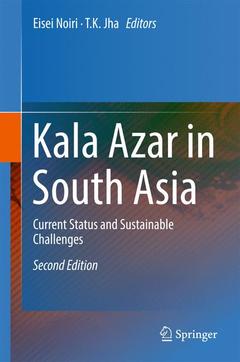Kala Azar in South Asia (2nd Ed., 2nd ed. 2016) Current Status and Sustainable Challenges
Coordonnateurs : Noiri E., Jha T.K.

Visceral leishmaniasis (VL), (also known as black fever or Kala-azar) is a life-threatening disease first reported from the Indian subcontinent. VL ranks as the world?s second largest parasitic disease killer and is a neglected tropical disease. Most of those infected by this life-threatening disease are uneducated daily wagers working to support their families, and vectors easily disseminate the disease to their neighbors. Owing to recent involvement of stakeholders, the number of patients is decreasing, but eradication remains a distant goal.
This second edition presents latest reports of visceral Leishmaniasis by specialists working at the forefront of the endemic areas in Indian subcontinent. It also introduces vaccine development and inhibitors to Trypanosomatidae; some of them describing feasibility studies in visceral Leishmaniasis for the first time.
Recent progress of the Science and Technology Research Partnership for Sustainable Development (SATREPS) is also reviewed and the contents share this collaborative research from the forefront of endemic sites in Bangladesh.
Widely covering basic, clinical, epidemiological and entomological aspects, this volume will be of great interest to dedicated researchers interested inLeishmaniasis and to experts of NTDs in global health.
There is a tide in the affairs of men. Which, taken at the flood, leads on to fortune; Omitted, all the voyage of disease control is bound in shallows and in miseries.
~modified from Shakespeare ~
Preface. Part I Introduction into Kala-Azar Pathology and Mechanism of Disease in Kala-Azar.-
Treatment of Post-kala-azar Dermal Leishmaniasis.- Characteristics of Patients Visiting Suruya Kanta Kala-Azar Research Center in Mymensingh, Bangladesh; Data from a Patient Registry System.- Epidemiology of Drug-Resistant Kala-Azar in India and Neighboring Countries.- Part II Therapeutic Strategy to Deal with Emergence of Drug Resistance.- A Therapeutic Strategy for Treating Visceral Leishmaniasis in Regions with Drug Resistance.- Treatment of Post-kala-azar Dermal Leishmaniasis.- Combination Therapy for Leishmaniasis.- Vaccine Development for Leishmaniasis.- Siccanin is a novel selective inhibitor of trypanosomatid complex II (succinate-ubiquinone reductase) and a potent broad-spectrum anti-trypanosomatid drug candidate.- Challenges in the Diagnosis of Visceral Leishmaniasis on the Indian Subcontinent.- Part III Diagnostic Strategy Enhancing Kala-Azar Elimination Program.- Changes of Leishmania antigens in kala-azar patients’ urine after treatment.- Potentiality of Urinary L-FABP Tests to Kala-azar Disease Management.- Antibody Capture Direct Agglutination Test (abcDAT) for Diagnosis of Visceral Leishmaniasis with Urine.- Loop-mediated Isothermal Amplification (LAMP): Molecular Diagnosis for the Field Survey of Visceral Leishmaniasis.- Applicability of Multiplex Real-Time PCR to Visceral Leishmaniasis.- Immunoglobulins in the Pathophysiology of Visceral Leishmaniasis.- Part V Knowledge and Practice for Vector Control in Kala-Azar.- Geographical Distribution and Ecological Aspect of Sand Fly Species in Bangladesh.- The efficacy of long lasting insecticidal nets for leishmaniasis in Asia.- Environmental change and kala-azar with particular reference to Bangladesh.- Part VI. New Challenges in the Kala-azar Elimination Programme.- Drug Safety Monitoring for Liposomal Amphotericin B.-
Resolution Mapping of Kala-azar Hot Spots Using GPS Logger and Urinary Antibody Measurements.-
Geography and Reality of Kala-azar Endemic in Bangladesh, Analysis Using GIS and Urine-based Mass Screening.- Animal Models of Visceral Leishmaniasis and Applicability to Disease Control.-
Pharmacovigilance on Therapeutic Protocols for Visceral Leishmaniasis. Index.
Provides strategies for the eradication of Visceral Leishmaniasis
Complete with updated knowledge and real-world information
Covers basic, clinical, epidemiological and entomological aspects
Includes supplementary material: sn.pub/extras
Date de parution : 01-2017
Ouvrage de 309 p.
15.5x23.5 cm
Disponible chez l'éditeur (délai d'approvisionnement : 15 jours).
Prix indicatif 158,24 €
Ajouter au panier


